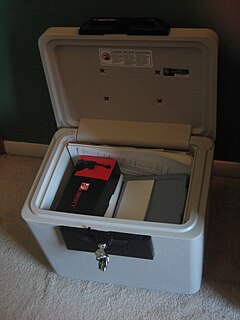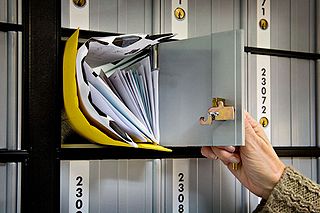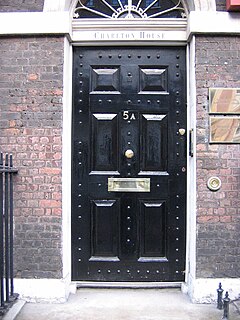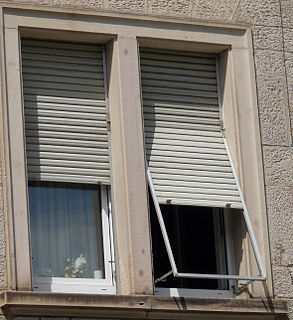
Lock, Stock and Two Smoking Barrels is a 1998 British crime comedy film written and directed by Guy Ritchie, produced by Matthew Vaughn and starring an ensemble cast featuring Jason Flemyng, Dexter Fletcher, Nick Moran, Jason Statham, Steven Mackintosh, Vinnie Jones, and Sting, Jones and Statham in their feature film debuts.

Box describes a variety of containers and receptacles used for the permanent storage or temporary transportation of its contents. The size of a box may vary, from the very smallest to the size of a large appliance, and can be used for a variety of purposes ranging from the functional to the decorative.

A lock is a mechanical or electronic fastening device that is released by a physical object, by supplying secret information, or by a combination thereof or only being able to be opened from one side such as a door chain.

A safe is a secure lockable box used for securing valuable objects against theft and/or damage from fire. A safe is usually a hollow cuboid or cylinder, with one face being removable or hinged to form a door. The body and door may be cast from metal or formed out of plastic through blow molding. Bank teller safes typically are secured to the counter, have a slit opening for dropping valuables into the safe without opening it, and a time-delay combination lock to foil robbers/and or thieves. One significant distinction between types of safes is whether the safe is secured to a wall or structure or if it can be moved around. A less secure version is usually called a cash-box. Safes can be found in hotel rooms, offices and houses.

A post office box is a uniquely addressable lockable box located on the premises of a post office station.

A bank vault is a secure space where money, valuables, records, and documents are stored. It is intended to protect their contents from theft, unauthorized use, fire, natural disasters, and other threats, much like a safe. Unlike safes, vaults are an integral part of the building within which they are built, using armored walls and a tightly fashioned door closed with a complex lock.

A letter box, letterbox, letter plate, letter hole, mail slot or mailbox is a receptacle for receiving incoming mail at a private residence or business. For the opposite purpose of collecting outgoing mail, a post box is generally used instead. Letterboxes or mailboxes use the following primary designs:

A Kensington Security Slot is part of an anti-theft system designed in the early 1990s and patented by Kryptonite in 1999–2000, assigned to Schlage in 2002, and since 2005 owned and marketed by Kensington Computer Products Group, a division of ACCO Brands.

A safe deposit box, also known as a safety deposit box, is an individually secured container, usually held within a larger safe or bank vault. Safe deposit boxes are generally located in banks, post offices or other institutions. Safe deposit boxes are used to store valuable possessions, such as gemstones, precious metals, currency, marketable securities, luxury goods, important documents, or computer data, which need protection from theft, fire, flood, tampering, or other perils. In the United States, neither banks nor the FDIC insure the contents. An individual can purchase separate insurance for the safe deposit box in order to cover e.g. theft, fire, flooding or terrorist attacks.

A chest is a form of furniture typically of a rectangular structure with four walls and a removable lid, for storage. The interior space may be subdivided. The early uses of an antique chest or coffer included storage of fine cloth, weapons, foods and valuable items. It is a box with a hinged lid that can safeguard your personal items. Some chests are equipped with locking mechanisms or a metal band that a lock can be secured on. In Webster’s Dictionary 1988 version, a chest is defined as a “a box with a lid and often, a lock, for storing or shipping things” or as “a cabinet as for holding medical supplies, toiletries, etc.”

Safe-cracking is the process of opening a safe without either the combination or the key.

A bicycle lock is a security device used to deter bicycle theft, either by simply locking one of the wheels or by fastening the bicycle to a fixed object, e.g., a bike rack.

A coffer in architecture is a series of sunken panels in the shape of a square, rectangle, or octagon in a ceiling, soffit or vault. A series of these sunken panels was often used as decoration for a ceiling or a vault, also called caissons ("boxes"), or lacunaria, so that a coffered ceiling can be called a lacunar ceiling: the strength of the structure is in the framework of the coffers.

A briefcase is a narrow hard-sided box-shaped bag or case used mainly for carrying papers and equipped with a handle. Lawyers commonly use briefcases to carry briefs to present to a court, hence the name. Businesspeople and other white collar professionals also use briefcases to carry papers, and since the 1980s, electronic devices such as laptop computers and tablet computers. Some briefcases have only a main internal space, while others may have subsections, accordion sections, small pockets, or dividers. Briefcases may be made from leather, vinyl, durable fabric, thin metal, or plastic. Leather, vinyl, or fabric briefcases may have externally-accessible pockets or sleeves in addition to the main storage space. Some briefcases made of fabric may have a shoulder strap. Briefcases typically have a lock to protect the contents. Nowadays, briefcases may have padded internal pouches to protect laptop computers.
An armlock in grappling is a single or double joint lock that hyperextends, hyperflexes or hyperrotates the elbow joint or shoulder joint. An armlock that hyperflexes or hyperrotates the shoulder joint is referred to as a shoulder lock, and an armlock that hyperextends the elbow joint is called an armbar. Depending on the joint flexibility of a person, armlocks that hyperrotate the shoulder joint can also hyperrotate the elbow joint, and vice versa.
A safe is a secure lockable box used for securing valuable objects against theft or damage.
Single-point locking is a locking system in cabinet doors where locking takes places only at the point halfway up the edge of the door, where the latch engages with the doorjamb. The term is most often used in items like lockers, where it is contrasted with the much more secure three-point locking, which uses movable rods to secure the top and bottom of the door when the door is locked, and the term is not normally used in situations where single-point locking is the only option normally found.

A roller shutter, coiling door, roller door or sectional overhead door is a type of door or window shutter consisting of many horizontal slats hinged together. The door is raised to open it and lowered to close it. On large doors, the action may be motorized. It provides protection against wind, rain, fire and theft. In shutter form, it is used in front of a window and protects the window from vandalism and burglary attempts.

The Three-stage quantum cryptography protocol, also known as Kak's three-stage protocol is a method of data encryption that uses random polarization rotations by both Alice and Bob, the two authenticated parties, that was proposed by Subhash Kak. In principle, this method can be used for continuous, unbreakable encryption of data if single photons are used. It is different from methods of QKD for it can be used for direct encryption of data, although it could also be used for exchanging keys.















